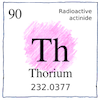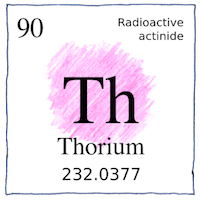Stockholm—Morten Thrane Esmark,
Jöns Jacob Berzelius
elements

|
Thorium
Actually, both Morten Thrane Esmark and his father, Jens Esmark, should be given credit. Morten found the mineral and his father, Jens, recognized it was something new and forwarded it to Berzelius. So Berzelius tested it and found that sixty percent of it was the oxide of a new element, and named it after the Norse god Thor.
Atomic number 90
Thorium is a soft ductile metal, softer than steel harder and lighter than uranium but it’s radioactive, with a half-life greater than the age of the universe decaying, eventually, to lead. It’s used in gas mantles heat-resistant ceramics and microwave-oven magnetrons.
Radioactive stuff
Depending on where you live damage could be accumulating. Radiation exists almost everywhere at least in small quantities. You’re born, you live a while and then you die. This pattern continues to repeat with significant variation until the clock of the universe is all unwound.



Esmark and Berzelius were not aware that thorium was radioactive. Marie Curie and Gerhard Carl Schmidt independently observed its radioactivity in 1898. What you don’t know might hurt you; however, radiation from thorium is so weak that you may handle it safely; it doesn’t penetrate the skin.
See also in The book of science:
Readings in wikipedia:
Other readings: